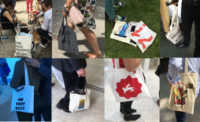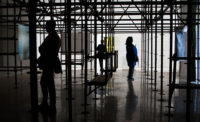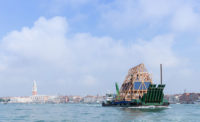Many of the architects participating in the current Venice Architecture Biennale are newcomers, and that’s how director Alejandro Aravena wanted it. The biennale’s five-member jury (including editor Karen Stein and MIT dean Hashim Sarkis) gave the Golden Lion, the highest award for national participation, to Spain for Unfinished, an exhibition of work by young architects who have created compelling buildings in the wake of that country’s financial crisis. Spain’s show, like the biennale overall, is about doing more with less. Still, there were plenty of starchitects at the biennale.
Bjarke Ingels was one of them. Hundreds of revelers joined him on a pair of chartered “pirate ships” for one of the biennale’s rowdiest parties.
The late Carlo Scarpa was also a presence. His small body of work includes the Giardini’s astonishing Venezuelan pavilion, an indoor-outdoor display case with signature Scarpa details, including hardware crafted as carefully as jewelry and collages of rough and smooth concrete. But the 60-year-old pavilion is badly in need of repair. Two years ago, the pavilion sat empty during the 14th Architecture Biennale. But this time it contains a terrific installation, mounted on a shoestring budget. Called Urban Force, it showcases dozens of community-funded and community-operated projects, all by young architects.
Urban Force’s sensibility couldn’t be more different from Scarpa’s. When asked about the pavilion, curator Alejandro Haiek said it’s "too much” for a country in the throes of an economic crisis. Perhaps. But even Haiek would like to see the building returned to its original glory. On a vaguely-worded sign, Venezuela announced plans to renovate the building, without giving a timetable. But if it wants to do something great for the next biennale, and indeed for architecture, it will tackle the renovation soon and then keep mounting shows like Urban Force.
The late Zaha Hadid, meanwhile, was the subject of a retrospective at the Palazzo Franchetti, assembled in just weeks. It contains hundreds of drawings, paintings, and models, crowded into vast, heavily-decorated 16th-century rooms (alarmingly, without climate control, which would seem to be necessary for such precious works). Dozens of Hadid’s friends gathered in the courtyard of the palazzo for a dinner to mark its opening. Even those who followed her career closely were astonished by the amount of material on display, and had to be wondering about plans for a permanent Hadid museum. Venice, already overcrowded, isn’t the place for such an institution, but it was nice to see Hadid's work, ornate in its own way, in such exquisitely detailed surroundings.
Young Firms and Starchitects Given Equal Weight at 2016 Venice Architecture Biennale

Spain’s pavilion won the Biennale’s Golden Lion award for its exhibition called Unfinished.
Photo © Thomas Mayer

Spain’s pavilion won the Biennale’s Golden Lion award for its exhibition called Unfinished.
Photo © Thomas Mayer

Urban Force, in Venezuela’s Carlos Scarpa-designed pavilion, showcases dozens of community-funded projects.
Photo © Thomas Mayer

Urban Force, in Venezuela’s Carlos Scarpa-designed pavilion, showcases dozens of community-funded projects.
Photo © Thomas Mayer

Zaha Hadid exhibition at the Palazzo Franchetti.
Photo © Luke Hayes

Zaha Hadid exhibition at the Palazzo Franchetti.
Photo © Luke Hayes

Zaha Hadid exhibition at the Palazzo Franchetti.
Photo © Luke Hayes

Zaha Hadid exhibition at the Palazzo Franchetti.
Photo © Luke Hayes

Zaha Hadid exhibition at the Palazzo Franchetti.
Photo © Luke Hayes

Revelers board Bjarke Ingel’s party pirate ships.
Photo © Architectural Record
Looking for a reprint of this article?
From high-res PDFs to custom plaques, order your copy today!
&



